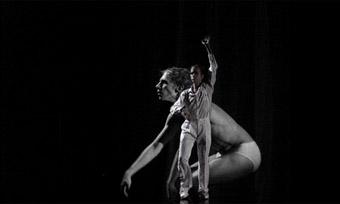anamorphic archive: the dancer reconfigured
jodie mcneilly

Martin del Amo, Anamorphic Archive, video still
Sam James
Martin del Amo, Anamorphic Archive, video still
Dancer Martin Del Amo steps partially into frame. His right palm draws out his arm to full length, pulling his body into the black space. He is a small figure inhabiting the background, dressed in white trousers, long sleeved shirt and braces. He is a white figure moving left from the edge of the frame towards the centre, arms at length away from his body. He repeats a movement of arm to the sides: right, left, left then right, palms facing the camera. His legs move on a lateral plane: apart then together, in equidistance. It is an act of precise positioning. Function with form: a body knowing where it is going, where it has been. And yet, on this screen, a dancer seemingly displaced.
Anamorphic comprises eleven short dance films produced by dance filmmaker and video artist Samuel James. Martin Del Amo’s work features amongst the work of other Sydney performers. James the documenter of these originally live works, has disturbingly treated and distilled the essence of these performers dispossessed of their performance locale. With Del Amo there are several drafts of a man stepping into and dissolving on screen, a man in all his measure. The doubling of his background image occurs early in the film, a second figure emerging out of step with its identical counterpart. A second del Amo is foregrounded, moving on the same plane. The facial expression suggests a being entrapped by a system of straightened arms spoking out from the torso, legs opening and head turning rapidly, relentlessly. Del Amo appears to seek depth in these separate tracks of flattened perspective and movement. We glimpse in his face a desire for respite, for change. A new arm movement traces a path into his body interrupting the sideways back and forth trajectory. The image deepens in dimension. A split screen halves the foregrounded dancer. The vertical line as axis placed over his midline invokes a third less defined del Amo who issues forth from the internal spaces of the front man. The trebled image induces an image of a tireless trio.

Martin del Amo, Anamorphic Archive, video still
Sam James
Martin del Amo, Anamorphic Archive, video still
Despite the repetition of movement, the pulses of these reproductions are neither regulated, nor stable. Del Amo’s head shakes intermittently as a result of James’ digital manipulation. It is a mark of subtle transgression. There is an overall sense that James’ post production assists Del Amo in his emancipatory action against the weight, direction and intensity of the situation. All these extra del Amos are supplied by James as versions varying in resolution, perspective, scale and colour. They arrive and leave the space with different intentions. Which one will be left to bear the consequences of this invisible assault? Under Attack, the original live work by Del Amo provides a fourth mostly naked del Amo: his sweating kernel emphasising the laboured process. The black and white image gives depth to the flattened perspective. He teeters on self-defined edges, his swinging torso unconstrained, no longer bound to any vertical axis. The other del Amos take their exits one by one. There is a sense of relief in this presence, like an authentic gut reaction to a problem which lies undefined. The dancer’s movement takes its shape from the rib cage which hovers over a well anchored body. He stands still with the visual hum of breath and looks out at an angle. There is resignation and a glint of defiance. He walks out of frame.
Sound Artist Gail Priest furthers the accumulation of this unfolding of a man under stress, a man aiming to get it right, with a sound suggesting repetitious, mundane purpose. A constant ache echoes within a machine’s industrial joints. As the inner del Amo extrudes, a violent tapping on a violin, highly strung, grows in fractals like a rash ad nauseam, invoking psychological tension. Both Priest and James in their applications of repetition show the devolution of a man within the promise of an unshakeable structure: he knows where he is going, what has been, but the present is unsettling.
Del Amo is like a little Russian babushka doll. At first the film’s form suggests ‘a similar object within a similar object’, but Sam James’ masterful manipulation of bodies in the dimensions of a filmic space makes complex the notion of peeling away outer layers. The inner emerges resolute through imbalances of scale, black and white costume in colour against black and white film, a split screen and superimposition. While the original live performance may remain a mystery to the film’s viewer, del Amo’s experience is distilled by his documenter, reconstituted and placed in new configurations: scattered little babushkas.






